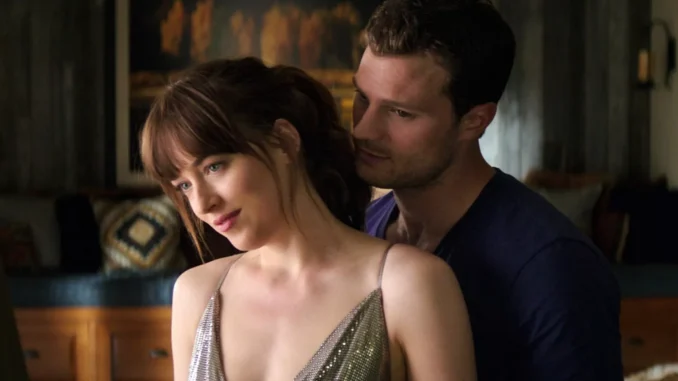
Fifty Shades of consent: How the erotic franchise helped start the conversation
To read more movie coverage, pick up the new issue of Entertainment Weekly on stands Friday, or buy it here now. Don’t forget to subscribe for more exclusive interviews and photos, only in EW.
:max_bytes(150000):strip_icc():format(webp)/000273445-2000-299751e342c84c0980f3354dc7d474e4.jpg)
Riding crops dragged across a naked back, silk blindfolds, and a camera panning over nether regions. And between all that, a good old-fashioned meeting of two consenting adults going over their sexual preferences point-by-point on paper. (Vibrators, okay. Dildos, fine. Genital clamps … absolutely not.)
Fifty Shades of Grey had no idea what it was getting into.
The first film hit theaters in February 2015, three years ago on paper but a figurative lifetime. Red carpets were dominated by GIF-able Jennifer Lawrence mishaps and Bradley Cooper’s bromances, not Time’s Up or the absence of Harvey Weinstein. No one — not the studio, the actors, or the audience — knew of the movement that was to sweep Hollywood and the nation.
The first novel in the series that preceded the movie franchise incited epic pearl-clutching when it hit shelves in 2011. Mothers who bought into the world of Anastasia Steele and Christian Grey were (gasp!) interested in exploring their sexuality, and maybe even bondage play. There was a strong sense of the books as guilty pleasure, something that should always be hidden inside the jacket of literally any other title, a sense that stemmed not just from the jarringly basic prose but rather (gasp again!) anal beads and handcuffs.
The release of the on-screen adaptation incited epic debates: What was and wasn’t wrong with its gender dynamics; what was considered problematic in Christian and Ana’s relationship; what qualifies as consent in the bedroom (or the Red Room of Pain). While there were some red flags — like the fact that, BDSM proclivities aside, Christian is kind of a d—), it was a first for this generation: That a piece of box-office-busting pop culture would get everyone talking about consent.
Not that most people bought their tickets for that. They flocked to the theaters because they wanted to see this guilty pleasure acted out on-screen by two impossibly sculpted actors, or to have a night out with friends lubricated by booze and actual lube, or to satisfy pure unbridled curiosity. However, what audiences got was an honest conversation between partners about what gives them pleasure. Ana and Christian’s back-and-forths about fisting and Ben Wa balls (they stepped it up for Fifty Shades Darker) played for laughs, but there was something more beyond the LOLs: The start of a national conversation.
This third and final film (the climax, if you will) arrives at a time when consent, good and bad sex, and the “enthusiastic yes” are being widely discussed and sensitivities are high — for good reason. It begs the question: How do we enjoy movies like Fifty Shades Freed in the #MeToo era?
The answer: Like everything, we look for the good.
Anyone who was left wanting more, ahem, “kinky f—ery” in the first two films won’t find themselves overly satisfied by Freed: If those films were softcore porn with a bit of romance tossed in, this new film is a romance with a bit of softcore tossed in. Ana and Christian are married now, and a life filled with name changes and job promotions and cooking dinner doesn’t leave much room for riding crops. But while Mr. Grey was learning to need his handcuffs a little less, he was learning the value of a sexual equal a little more.
Christian’s not an entirely changed man, of course: He needs to be persuaded that Ana is capable at every turn, that she isn’t a child but in fact a grown woman who can drive a car and go out with friends all by herself. But under the sheets (well, had they used sheets) he’s (gasp yet again!) listening. The safe word is still in play — consent doesn’t go out the door with a wedding ring. Ana uses it loud and clear, giving him a dressing-down (“Don’t use the Red Room to even the score”) and she, for what feels like the first time, initiates sex and tells her husband to sit back and watch.
It’s not perfect sexual politics, but no one is asking Fifty Shades Freed to be perfect. Audiences seek closure after they’ve devoted several years of their lives to the O-faces of perfect strangers. So we take the small victories as they come, and then sit back, whistle-fingers at the ready, hoping for a flash of Jamie Dornan full-frontal.
